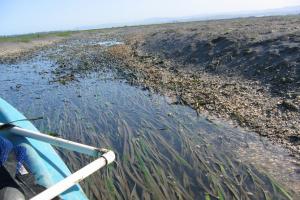(707) 839-5130 | Contact Us
Predicted Eelgrass Response to Sea Level Rise and Implications for Foraging Black Brant
In collaboration with Drs. Jeff Black and Frank Shaughnessy of Humboldt State University, David Ward of the USGS, and Dr. Mark Petrie of Ducks Unlimited, we modeled the effects of relative sea level rise on eelgrass (Zostera marina) habitat area and on the amount of that area that is accessible to brant (Branta bernicla), a migratory goose that feeds on eelgrass. Sea level rise will affect the capacity of estuaries along the Pacific Flyway to support traditional numbers of brant. Digital elevation models were developed for seven estuaries from Alaska, Washington, California, and Mexico. Future distributions of eelgrass were derived from estuarine specific tectonic and sediment change rates in conjunction with three rates of eustatic sea level rise (ESLR). Percentage of total eelgrass area accessible to direct brant grazing was determined for December when brant overwinter and during April when they use sites for fattening prior to northward migration. Accessibility was affected by variables such as daytime tide height that limit brant reaching depth. Model projections 100 years into the future indicated that present day ESLR and bottom change rates (i.e. tectonic plus sediment change rates) should sustain the current estuarine pattern of brant overwintering, migrating and breeding across the flyway, but eelgrass beds at the northern and southern extremes of the flyway may contract if ESLR accelerates. High sedimentation rates may be the greatest threat to eelgrass habitat in southern estuaries regardless of ESLR rate. Management responses to model projections are limited primarily to the increase or decrease of sediment supply rates and the relocation of structures such as levees to allow for upslope migration of eelgrass habitat. The manuscript developed in conjunction with this study was published by the Ecological Society of America in September 2012.
- 19 of 26
- Projects:
- ‹ previous
- next ›




